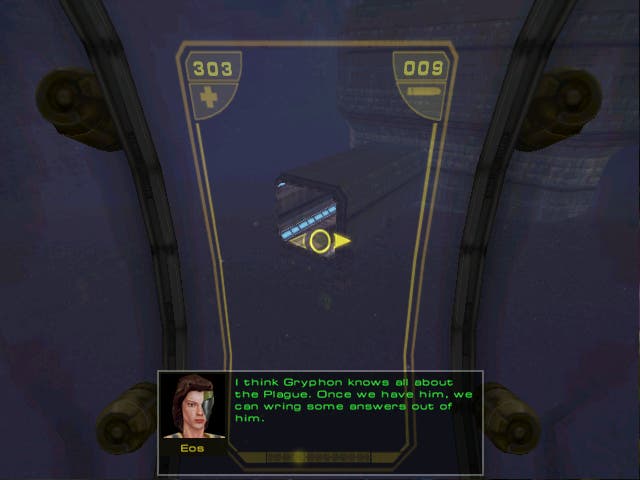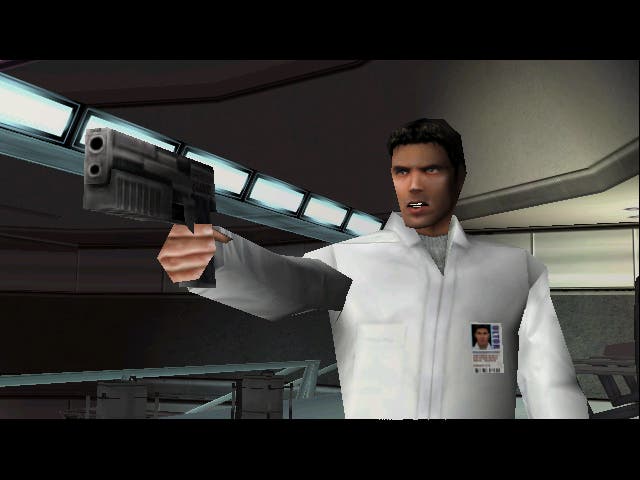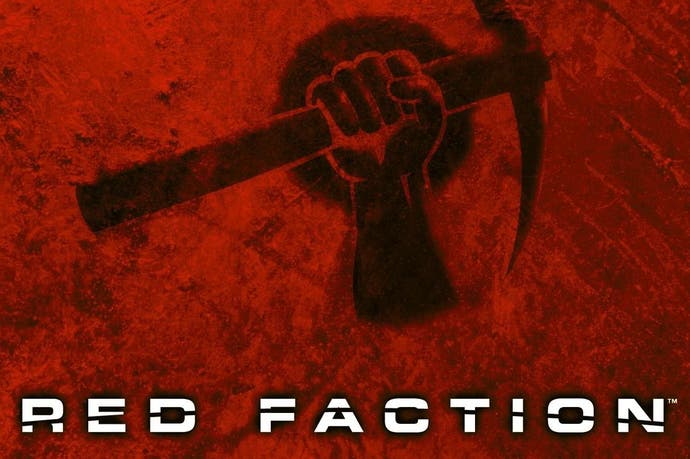The making of Red Faction
Where there's a wall there's a way.
The Red Faction series hasn't had it easy of late. First the franchise was deemed too niche before being unofficially side-lined in 2012 by THQ; subsequently the publisher itself (and owner of developer Volition) entered financial difficulties at the end of last year, eventually yielding to bankruptcy. Despite its enduring popularity, the future of Red Faction was in serious doubt.
Then came the great THQ asset auction, in which the series was acquired by Swedish company Nordic Games alongside another major IP, Darksiders. So far, news of a fresh instalment of the Mars-centric series has been elusive; however, with a Red Faction compilation announced by Nordic a few weeks ago, now seems like the perfect time to revisit the very first game.
Yet the story of Red Faction doesn't begin at THQ, or even Volition. In 1993, Mike Kulas and Matt Toschlog formed Parallax Software, where they created the highly successful and widely respected Descent games. When the company was mutually split in 1997, Kulas formed Volition Inc. and begun development of the Freespace series, with the challenge of producing a follow-up to Descent 2 falling to Matt Toschlog's Outrage Entertainment. The result, Descent 3, was a poor seller but a further game in the series was already underway.

"The market had changed - joysticks were being replaced by the mouse/keyboard combination for PC games and the Descent brand as it was wasn't strong enough to warrant another sequel," says Alan Lawrance, who joined Volition in 1996 and worked on Descent 4. The original idea had been to create a sequel with destructible environments and the player controlling a character rather than a spaceship. The failure of Descent 3 in the marketplace demanded a change of plan.
"We felt that destructible environments held a huge amount of promise," says Lawrance, "so we decided to remain focused on a first-person shooter with this concept. That's where Red Faction was born, although we had a choice of two names - that or Red Shift. It could have gone either way, and we liked them both." Lawrance became lead designer of the new project and the Descent brand joined forces with Volition's Freespace to create space combat simulation Descent: Freespace The Great War.
But that's another story. Red Faction is the tale of a miner named Parker. Tempted to the red planet by a greedy corporation's promise of adventure and easy money, he arrives to find the situation somewhat different. The corporation is Ultor, named appropriately enough, after an ancient Roman temple in honour of the God of War. When Parker witnesses a brutal assault on a fellow miner by an Ultor guard he is suddenly caught up in a dramatic rebellion; it's kill or be killed as all hell breaks loose.
Pre-production of Red Faction began in the winter of 1998 with the team acutely aware of the strong competition within the first-person shooter genre. Dark Forces 2: Jedi Knight had been released earlier in the year as had Epic's Unreal and, of course Half Life. It was going to be a tough field.
"It was a remarkably small team by today's standards," recalls Lawrance, "but everyone was able to give input on the story and characters if they wanted to. We knew of the competition but were very focused." Key members of the Red Faction team included Volition founder Mike Kulas, who assisted on the design side before the pressures of running the company limited his input; lead programmer John Slagel; lead artist Frank Capezzuto; level-designer Matt Boynton and Mike Breault, the writer responsible for the game's story and dialogue.

"Mike was behind most of the plot, but fleshing out the details was actually a collaboration between multiple members of the team. It was an interesting way of working." recalls Lawrance. And talking of the plot, it must have been influenced by a certain Arnold Schwarzenegger movie from eight years earlier? "There are certainly a few parallels between Red Faction and Total Recall," he smiles, "but I don't ever recall us discussing that as a source of material or inspiration for the game. It only dawned on us later that there were a lot of similarities, not least the setting and rebellion themes."
It was apparent from the start that Volition would need to create a new engine from scratch to incorporate their ambitious plans. Red Faction would be the first in its genre to feature fully destructible walls and structures, at least in a form that was integral to the gameplay. The technique became known as geo-mod - short for geometry modification.
"There are a lot of technical challenges with arbitrary destruction," says Lawrance, "which is why games back then generally avoided it." Volition's original grandiose plan to have literally every part of the game destructible was soon abandoned. "We had limited physics support for the destruction and also the linear nature of the gameplay made it necessary to funnel the player through the game, which obviously didn't permit the freedom anyway."
As Red Faction began to take shape, more issues that Volition hadn't anticipated began to surface; geo-mod was causing a series of related technical problems that tested the team to the limit. "It definitely made other systems more difficult." says Lawrance. "Rendering the world fast enough became trickier since we couldn't pre-compute visibility. Additionally, AI was more difficult as path finding had to account for holes in the ground and walls. In fact, the game design in general became more challenging since the destruction could easily break scripting and cause a bug or crash."
Despite these hiccups, Volition's publishing partner obviously saw the potential; during Red Faction's development, they acquired the developer, keen to expand their publishing business outside of its successful line of children's videogames. And THQ's desire to have the game focused on a new console platform was a sensible, if troublesome move for the previously PC-driven developer.
"It was certainly interesting when we were asked to do the PlayStation 2 version of the game," recalls Lawrance neutrally, "as many changes to the PC-centric codebase at Volition were required so Red Faction would not only squeeze into the console, but also function at an acceptable standard." A prime example was the dynamic memory allocations the team used: "It was too slow and could lead to running out of memory on consoles with a fixed RAM, so we had to eliminate all of that from our code." It was nothing Volition couldn't solve, though it was time consuming, resulting in the game slipping 'at least once' according to the lead designer. "But THQ were very supportive and gave us the time we needed to properly finish the game." Eventually Red Faction's PC port would be practically identical save the addition of online multiplayer with the PS2 version offering just two-player split screen multiplayer mayhem.

Red Faction was finally released in 2001, with the PlayStation 2 version landing a few months prior to its PC port. Reviews were positive, especially for the PS2 version, perhaps influenced by a relative lack of rival first-person shooters on Sony's console at the time. Volition were understandably chuffed, yet Lawrance freely admits the game wasn't perfect. "The scope of Red Faction was limited by our relatively small team size and budget, so it was always tempting to sneak more elements in. But every new feature takes time and that means less time spent polishing the features you already have. Some of the story we didn't need as well; for instance, I think Ultor was shown as quite evil enough without the plague sub-plot."
It had been a test for the team to find a setting that was fresh but didn't put off potential customers and the weapons felt ever-so-slightly stereotypical (although the brilliant infrared-scoped rocket launcher went some way to alleviating this); these were valid criticisms, according to Lawrance, but in no way detract from his pride on helping create Red Faction. "It was a pioneer in destructible environments and for that alone I think Red Faction will be well remembered in the history of first-person shooters. It was also one of the first console FPS games to use dual analogue sticks, which was a new thing back then."
Red Faction became THQ's biggest money-spinner prior to the Saints Row games, despite the original only receiving a PC and PlayStation 2 release (Volition didn't have strong enough cross platform technology to dedicate the time and effort into Xbox or GameCube versions). Its direct sequel may not have been as well-received but the series has a solid fan-base, bolstered by the games' defining destructive streak. And in spite of the flaws of the original engine, Lawrance still believes they were right to base the game around said the feature. "I think ultimately geo-mod was worth the efforts and trade-offs. It gave Red Faction an identity and helped differentiate it from other similar games. I believe there's still unexplored potential with destructible environments too."
Alan Lawrance worked at Volition for almost 17 years from October 1996 until April 2013. He was involved in all of the Red Faction games developed during this period and although his roles often changed - he was lead programmer on Red Faction 2, helped code multiplayer in Guerrilla and was a systems architect and rendering programmer on Armageddon - he still has fond memories. "I was given great opportunities to prove myself in design and programming on the Red Faction games, which really helped me build a career at Volition," he says. "And the original was also my first console project, so it opened my eyes on how to develop with a limited memory and fixed hardware. Before then, I'd admit to having some bad programming habits that you could get away with as a PC developer!"
It may have lacked the complexity and strong storyline of Half-Life, and an industrial Mars was certainly incomparable in aesthetic beauty next to Unreal's exotic Na Pali; but Red Faction remains an uncomplicated, muscular and fun shooter, chock full of enough flying glass, rock and concrete to give a health and safety officer a coronary. Here's hoping it's resurrected sooner rather than later.

